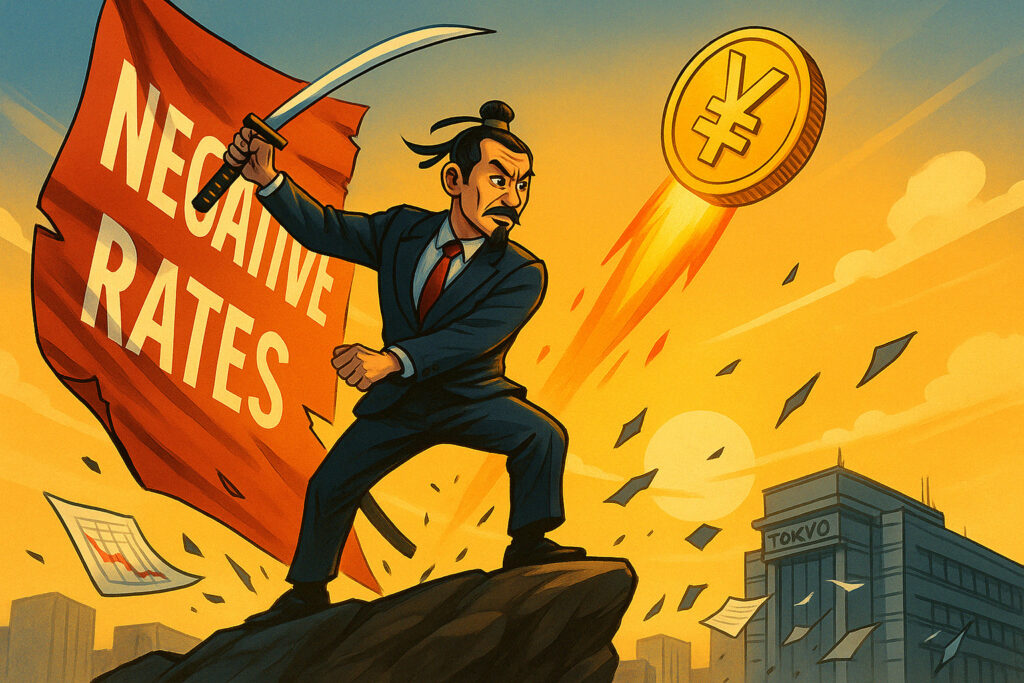Market Snapshot – March 16, 2025
- USD/JPY: ▼ 145.10 (–1.9%)
- Nikkei 225: ▼ 37,880.50 (–2.1%)
- TOPIX: ▼ 2,640.60 (–1.6%)
- 10-Year JGB Yield: ▲ 0.88% (+12 bps)
- USD Index (DXY): ▼ 103.55 (–0.5%)
BoJ Drops the Dovish Curtain: Policy Shift in Sight?
In a major shift that could reshape Japan’s economic landscape and global capital flows, the Bank of Japan (BoJ) signaled today that it is preparing to end its long-standing negative interest rate policy, which has been in place since 2016. Governor Kazuo Ueda, speaking after the BoJ’s closed-door policy review, hinted that Japan’s inflationary environment has become “sufficiently sustainable,” warranting “serious discussion about normalization.”
This marks a historic departure from the BoJ’s ultra-loose policy stance that for years placed it as an outlier among major central banks. Investors across FX, bonds, and equities swiftly recalibrated, sending the Japanese yen sharply higher, and Japanese equities tumbling on concerns of tighter monetary conditions ahead.
The Yen Soars: Currency Traders React
The USD/JPY pair fell as much as 2.1% intraday, breaking below the psychological 146 barrier to touch 145.10, its strongest level since mid-January. The move came on surging expectations that the BoJ could hike as early as April, especially after key wage negotiations earlier this month showed a 5.2% annualized increase—the strongest in three decades.
FX Market Takeaways:
- Carry trade unwind: Higher JPY expectations may trigger a broader unwinding of yen-funded carry trades, potentially adding volatility across emerging markets and risk assets.
- Real yield implications: With the 10-year Japanese government bond yield rising 12 basis points to 0.88%, real yields in Japan are turning less negative, supporting the yen’s newfound strength.
Japanese Equities Slide: From Easy Money to Exit Risk
The Nikkei 225 shed 2.1%, posting its worst single-day drop in over a month. Export-heavy names like Toyota (-3.6%), Sony (-3.1%), and Hitachi (-2.8%) were among the biggest losers. Markets have been pricing in continuing support from a weak yen, and a reversal threatens corporate earnings dependent on FX tailwinds.
Tech and REIT sectors, which have benefited from years of low-rate stimulus and cheap capital, also faced heavy selling.
Sector Breakdown:
| Sector | Performance |
|---|---|
| Exporters | –3.4% |
| Real Estate | –2.7% |
| Financials | +1.2% |
| Utilities | –1.8% |
| Industrials | –2.9% |
Financials were the only green spot, as a steeper yield curve bodes well for Japanese banks, many of which have struggled under years of compressed net interest margins.
Repricing Global Risk: Impacts Beyond Japan
The BoJ’s policy hint sent ripples beyond Tokyo. Investors are grappling with the global implications of a stronger yen and rising JGB yields:
- U.S. Treasury yields dipped modestly as investors reallocated from Japanese bonds.
- Asian EM currencies weakened, with the Indonesian rupiah and Thai baht down ~0.6%, pressured by a reversal in carry trade dynamics.
- Gold climbed 0.8% to $2,165/oz, partially on safe-haven bids and weaker USD.
In the currency derivatives market, the 1-month implied volatility on USD/JPY rose to 12.3%, the highest since October 2023, highlighting the uncertainty about the BoJ’s timeline and the potential for policy surprises.
Why This Shift Matters
Since the introduction of Negative Interest Rate Policy (NIRP) in 2016, the BoJ has aimed to spur inflation, boost lending, and support growth in a demographically challenged, deflation-prone economy. But after nearly a decade of global rate hikes and a dramatic surge in Japan’s core CPI (now at 2.7% YoY), the tide has finally turned.
What’s Changed?
- Inflation has proved sticky, even as global commodity prices normalize.
- Wage growth is finally accelerating, with union negotiations showing robust outcomes.
- Yen weakness has exacerbated import inflation, undermining purchasing power and political support for ultra-loose policy.
Governor Ueda’s comments today reflect a growing internal consensus within the BoJ that the era of NIRP has outlived its usefulness.
What’s Next?
Markets will now focus on the BoJ’s April meeting, where policymakers could:
- End NIRP by lifting the policy rate to zero or higher.
- Adjust Yield Curve Control (YCC) parameters to allow greater volatility in long-term rates.
- Signal a roadmap for gradual tightening, particularly if inflation continues to overshoot.
Economists from Nomura, Goldman Sachs, and Morgan Stanley have revised their BoJ rate hike forecasts, now expecting a first hike in Q2 2025, with two more by year-end.
Final Thoughts: The Last Dove Turns Hawkish
The BoJ’s pivot has been long in the making, but today’s announcement marks a definitive crack in the dovish armor that defined Japanese monetary policy for a generation.
While normalization may be gradual, the psychological shift—for policymakers, businesses, and markets—is profound. A stronger yen, rising yields, and a reorientation of Japanese capital flows could reshape the global investment landscape in 2025 and beyond.
